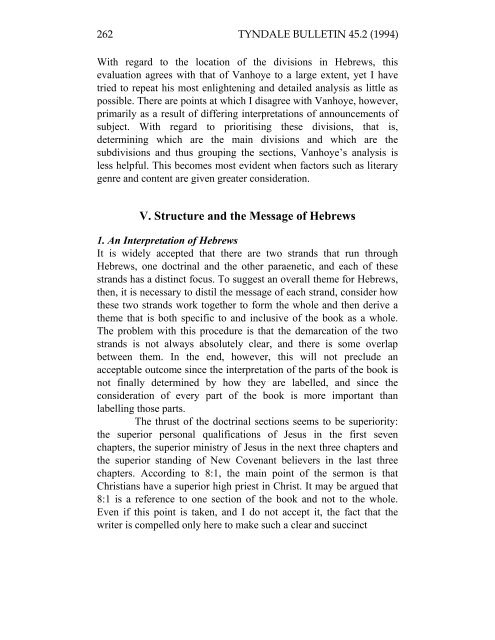the structure of hebrews from three perspectives - Tyndale House
the structure of hebrews from three perspectives - Tyndale House
the structure of hebrews from three perspectives - Tyndale House
You also want an ePaper? Increase the reach of your titles
YUMPU automatically turns print PDFs into web optimized ePapers that Google loves.
262 TYNDALE BULLETIN 45.2 (1994)<br />
With regard to <strong>the</strong> location <strong>of</strong> <strong>the</strong> divisions in Hebrews, this<br />
evaluation agrees with that <strong>of</strong> Vanhoye to a large extent, yet I have<br />
tried to repeat his most enlightening and detailed analysis as little as<br />
possible. There are points at which I disagree with Vanhoye, however,<br />
primarily as a result <strong>of</strong> differing interpretations <strong>of</strong> announcements <strong>of</strong><br />
subject. With regard to prioritising <strong>the</strong>se divisions, that is,<br />
determining which are <strong>the</strong> main divisions and which are <strong>the</strong><br />
subdivisions and thus grouping <strong>the</strong> sections, Vanhoye’s analysis is<br />
less helpful. This becomes most evident when factors such as literary<br />
genre and content are given greater consideration.<br />
V. Structure and <strong>the</strong> Message <strong>of</strong> Hebrews<br />
1. An Interpretation <strong>of</strong> Hebrews<br />
It is widely accepted that <strong>the</strong>re are two strands that run through<br />
Hebrews, one doctrinal and <strong>the</strong> o<strong>the</strong>r paraenetic, and each <strong>of</strong> <strong>the</strong>se<br />
strands has a distinct focus. To suggest an overall <strong>the</strong>me for Hebrews,<br />
<strong>the</strong>n, it is necessary to distil <strong>the</strong> message <strong>of</strong> each strand, consider how<br />
<strong>the</strong>se two strands work toge<strong>the</strong>r to form <strong>the</strong> whole and <strong>the</strong>n derive a<br />
<strong>the</strong>me that is both specific to and inclusive <strong>of</strong> <strong>the</strong> book as a whole.<br />
The problem with this procedure is that <strong>the</strong> demarcation <strong>of</strong> <strong>the</strong> two<br />
strands is not always absolutely clear, and <strong>the</strong>re is some overlap<br />
between <strong>the</strong>m. In <strong>the</strong> end, however, this will not preclude an<br />
acceptable outcome since <strong>the</strong> interpretation <strong>of</strong> <strong>the</strong> parts <strong>of</strong> <strong>the</strong> book is<br />
not finally determined by how <strong>the</strong>y are labelled, and since <strong>the</strong><br />
consideration <strong>of</strong> every part <strong>of</strong> <strong>the</strong> book is more important than<br />
labelling those parts.<br />
The thrust <strong>of</strong> <strong>the</strong> doctrinal sections seems to be superiority:<br />
<strong>the</strong> superior personal qualifications <strong>of</strong> Jesus in <strong>the</strong> first seven<br />
chapters, <strong>the</strong> superior ministry <strong>of</strong> Jesus in <strong>the</strong> next <strong>three</strong> chapters and<br />
<strong>the</strong> superior standing <strong>of</strong> New Covenant believers in <strong>the</strong> last <strong>three</strong><br />
chapters. According to 8:1, <strong>the</strong> main point <strong>of</strong> <strong>the</strong> sermon is that<br />
Christians have a superior high priest in Christ. It may be argued that<br />
8:1 is a reference to one section <strong>of</strong> <strong>the</strong> book and not to <strong>the</strong> whole.<br />
Even if this point is taken, and I do not accept it, <strong>the</strong> fact that <strong>the</strong><br />
writer is compelled only here to make such a clear and succinct
















